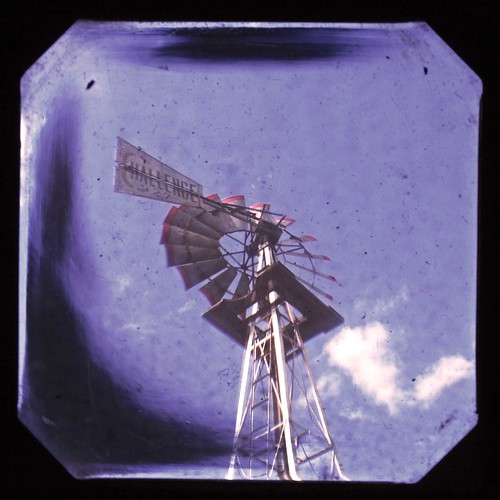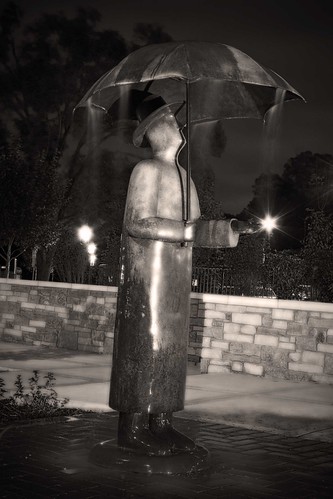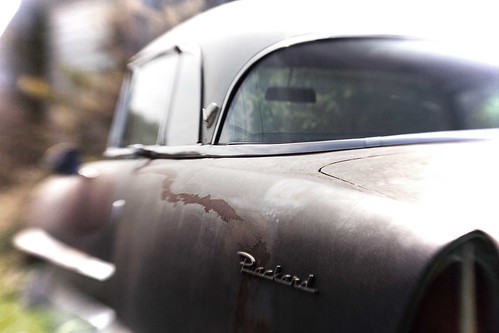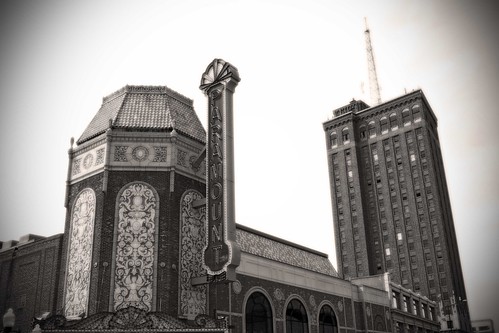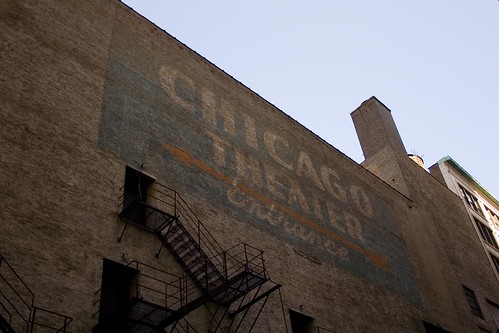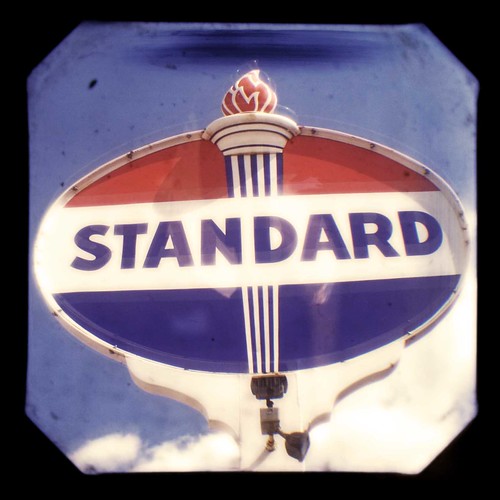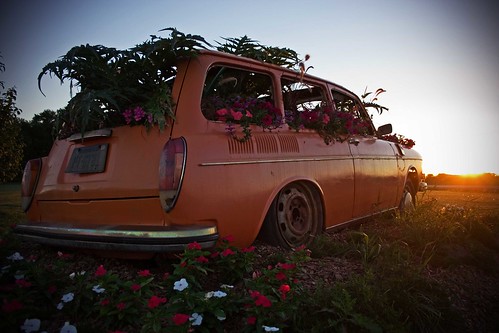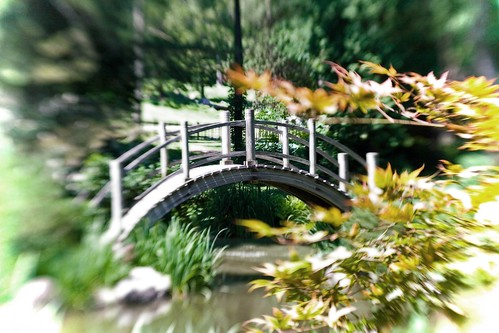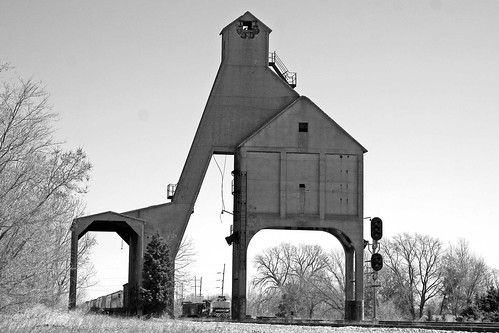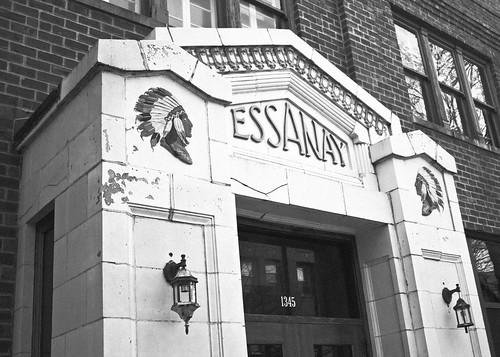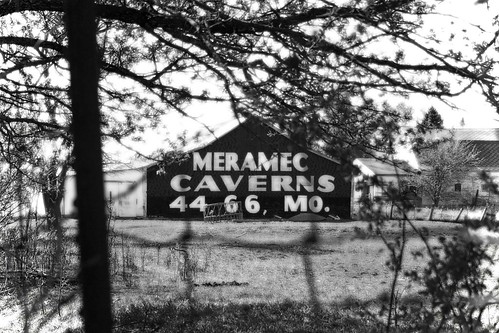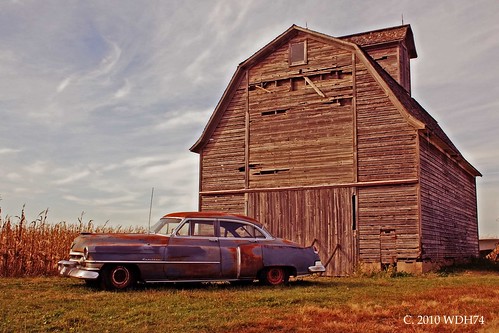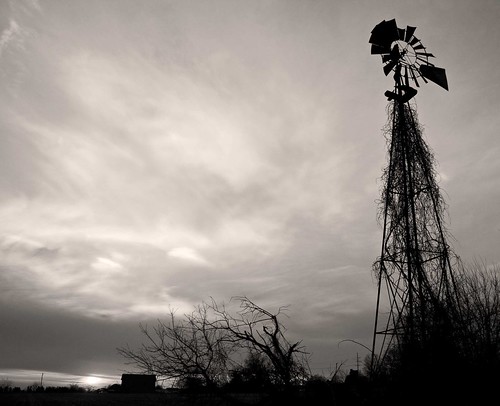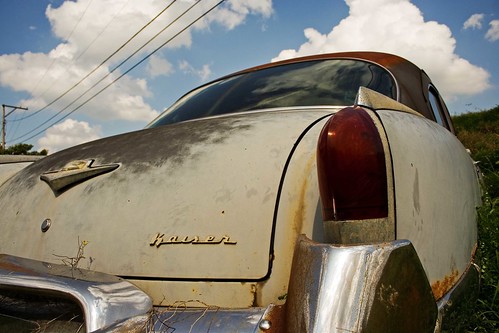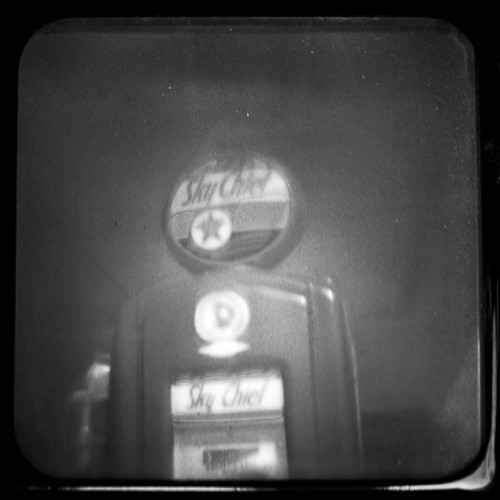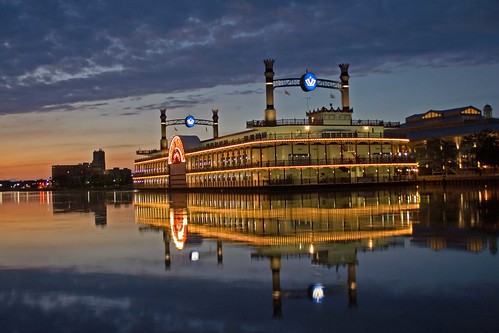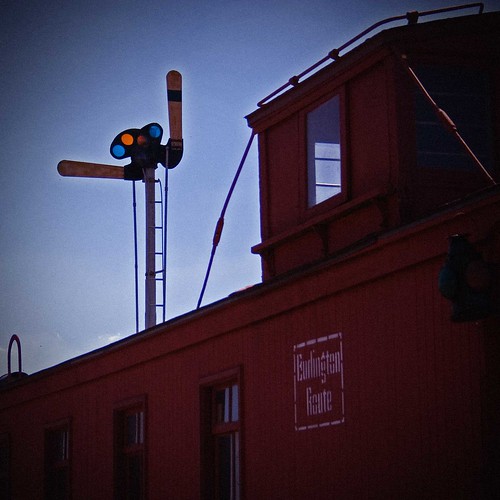The Challenge Windmill Company of Batavia, Illinois was one of the Midwest's largest windmill manufacturers, and it's said that something like a third of all windmills in the plains states came from this company.
Batavia is rightfully proud of this history, and has a good collection of vintage, restored windmills on display near the downtown area. This one's a classic Challenge Model 27, one of the company's most popular designs.
I've shot the windmill collection several times, and this particular shot was taken through the viewfinder of one of my Spartus Full-Vue cameras. I've been doing a lot of TtV photography lately. I'll be boring you all with it some more, rest assured!
Sunday, October 31, 2010
Model 27
Saturday, October 30, 2010
Looks Like Rain
This piece of art stands in downtown Geneva, Illinois, near the end of a row of shops and restaurants. Water comes out the top of the umbrella, cascading down, making a fairly good impression of someone being stuck in the rain and adding a nice little bit of action to what would otherwise be a static display. Which makes me wonder if this is a statue or a fountain?
I can say that it's not unusual to see people huddling under the umbrella to have their photos taken.
Friday, October 29, 2010
Turbines
So, I was out one summer evening, trying to shoot some photos of a grain elevator at sunset, but I'd not bothered to get proper directions so I was hopelessly lost, driving around these straight, hilly country roads that all looked pretty much the same in the darkening twilight. Well after the golden light had gone I found myself on a main north south route heading in the wrong direction to go back home, so I pulled over to wait out the couple of cars behind me so I could hang a U-turn.
Good thing I did, don't you think? Funny how things work sometimes.
Thursday, October 28, 2010
Ask The Man Who Owns One
In the 1920's and 30's, Packard had a reputation for being the top of the heap among American luxury car manufacturers, despite being an independent and lacking the backing of one of Detroit's major manufacturers. Their cars combined elegant styling with hand built quality and reliability into a luxurious package, a trend that continued post war when the company-like most-simply updated a prewar model. By the early 1950's, Packard had updated it's styling, but without the financial backing of a company such as General Motors or Ford, they couldn't afford yearly model changes, and simply opted to gently massage their existing shapes. By the middle of the decade their cars were looking decidedly frumpy, conservative cars for conservative people.
That all changed in 1955. Stylist Richard Teague was called on to completely revamp the company's lineup, a task he succeeded at. Gone were the rounded forms and antiquated postwar austerity, and in were modern sharp lines and jazzy two tone paint. Packard also took the opportunity to revamp the car's mechanical bits, with all new suspension and the company's first modern V-8 engines. Luxury touches abounded, with pushbutton automatic transmissions, air conditioning, and electric windows. Packard was back.
It didn't last, though. Plagued with reliability issues with the transmissions and electric gearboxes, Packard sales fell through 1955 and '56, consistently lagging behind Lincoln, Chrysler, and the new king, Cadillac. By 1957 the company had merged with Studebaker of South Bend, and the cars were more Stude than Pack, and by 1959 the name was gone completely.
This car is a Four Hundred, which was the two door coupe model built during those two glorious years (the other two were the four-door Patrician and the sexy Caribbean convertible). It's a very elegant car, and it looks great in two tone black and white, with a red interior. I have no idea why it's sitting there, quietly returning to ground, but I imagine it must have been a serious mechanical malady. But there it is, with a quiet dignity, holding it's head high, the end of an era.
Wednesday, October 27, 2010
Via Subway
When you talk about trains and Chicago, the first thing that pops into most peoples' minds is the elevated railroad, the famed 'L' trains that give the equally famed Loop it's name. Fewer people (who aren't locals, that is) know that there's also a subway system, two lines that dive below the streets to pick up and drop off Loop bound riders. Completed in 1943, the State Street Subway provided two new tracks, bypassing some of the slower sections above ground and allowing express trains for riders heading to outlying stations on the system. The Dearborn Street Subway would be started, but war shortages meant it remained incomplete, and it wouldn't open until 1951.
Both the State and Dearborn subways remain in use today, as part of the Red and Blue Lines respectively. Unlike their more ornate cousins in London and New York, the Chicago subways are relatively stark and functional-a product of their times, the early 1940's, as the world was plunging into war. Several have since been remodeled, but a few stops remain in their original form. Clark & Division is the second most northerly stop on the Red Line, and remains pretty much as it was when it opened, with plain white concrete arched ceilings, unadorned steel I-beam supports, and a red no-slip floor.
Clark also has a smattering of original signage, including a couple of these "Type F" illuminated station signs, which date from the station's opening in 1943. They feature bold Futura fonts, which was common to all the original signs in the subway, and lends an Art Deco feel to them. I always liked these signs, and they always caught my eye when I rode through Clark.
The only other Type F signs in the system are at Clinton, on the Blue Line.
Tuesday, October 26, 2010
City of Lights
Aurora is the second largest city in Illinois, and is located along the Fox River about 30 miles from Chicago. Officially incorporated in the 1850's, Aurora was one of the first cities in the country to implement all-electric street lighting, and gave itself the nickname "The City of Lights". The city grew quickly, attracting manufacturing and becoming a bit of a railroad hub, featuring a large Chicago, Burlington, and Quincy shop complex, as well as being one of the termini for the Chicago, Aurora, and Elgin interurban. The CB&Q roundhouse still stands, as part of the Aurora Transportation Center.
In common with many larger cities, manufacturing started to leave Aurora in the 70's, hastening a decline of the downtown area as shoppers left to go to outlying malls. In 1993 a riverboat casino was built, which started an economic resurgence of the area, particularly around Stolp Island, a resurgence that has continued today.
Pictured here are downtown Aurora's signature buildings-the Paramount Theatre, and the Leland Tower. The Paramount was built in 1931, and was designed by noted theater architects Rapp & Rapp. Over the years it featured stage plays, films, live music, comedy acts, and a variety of other shows, and in 1980 was added to the National Register Of Historic Places.
The Leland was completed in 1938, and was at one time the tallest building in Illinois outside of the city of Chicago. It stands 22 stories and dwarfs everything in the downtown historic district. Originally a hotel, the Leland featured all the amenities of the time, including telephones in every room! The topper-literally and figuratively-was the Sky Club, a luxuriously fitted out dinner and dancing club. It proved to be quite popular, with people coming out from Chicago to enjoy the views afforded by the club's height. By the 1960's the hotel had closed down, and the Leland ultimately became a building of apartments, many of which have those spectacular views of the Fox River Valley that made the Sky Club so popular.
Monday, October 25, 2010
Chicago Theater
By 1921, Balaban & Katz had several major movie palaces located throughout the Chicago area, and was well on it's way to being the theater powerhouse it ended up becoming. Typically B&K chose to open theaters in outlying areas, hoping to serve a growing middle class, but in 1921 they opened up the Chicago Theatre , right downtown on North State Street. It proved to be the firm's flagship and was the dominant theater in the Loop until the late 40's.
Designed by legendary theater architects Rapp & Rapp (who also did the Uptown and Oriental theaters for B&K) , the Chicago was one of the first theaters to be built in R&R's neo-baroque style. It's also the oldest example still surviving in Chicago, and features a six-story tall arch over the State Street entrance, a Tiffany stained glass window, and a replica of the original neon marquee (which is with the Smithsonian). Inside, the lobby shows a heavy French influence, and features murals, chandeliers, and gilded accessories. In all, it's a grand place, and fitting of it's nickname "The Wonder Theater of the World".
This sign is in an alley off State, and is pretty well hidden unless you're cutting between State and Wabash. The font and general style date stamps this to the fifties or early sixties, probably before the building next door was put up. I'm surprised it's still hanging in there- you find old painted signs like this all over the city, but usually they're scrubbed off the more famous ones.
Sunday, October 24, 2010
Out to Pasture
I've noticed, in my travels, that you'll often find an old farm or other rural business that's got a little stash of old cars and trucks tucked in a back corner, quietly going to ground. Usually they date from the last few decades, trucks from the 70's and 80's, big Chevy Caprice Classic sedans, the occasional minivan. Once in a while you'll find something really old.
Such is the case here. This is a Chevrolet half ton truck, about a '35 or '36. It's parked out back of a tractor repair shop, and amazingly seems to have been in the same family since new. Like all cars, trucks aren't immune to being sold on, repaired, taken apart, and modified down through the years. I have no idea how long it's been sitting here, or what (if any) malady caused it to be left to rust away.
Saturday, October 23, 2010
On the Atchison, Topeka, and Santa Fe
The Atchison, Topeka, and Santa Fe Railroad was one of the largest roads in America, stretching from Chicago to the Pacific, through the lower midwest and the desert southwest. Although a major freight hauler (and one of the pioneering railroads behind intermodal shipping), the Santa Fe was probably best known for it's passenger trains, particularly the Chief series. The Chiefs were renowned for their speed and luxury, and the Santa Fe was one of the first railroads to feature dome cars and bi-level coaches. The Chief survives today as Amtrak's Southwest Chief, which runs from Chicago to Los Angeles.
This tiny depot is in the town of Mazon, Illinois, which is well south and west of Chicago on what is now the BNSF line. It's a fairly typical small town depot, and still has a brick platform next to the tracks. It's still in use today as a line office, and still features the old, pre-1960 Santa Fe logo.
Friday, October 22, 2010
Built to Last
Constructed in 1892, the Kane County Courthouse is one of the architectural highlights of the city of Geneva, Illinois. Romanesque in style, it is constructed of red brick and limestone, and features a square dome and arched entryways. However, one of the defining features sits out front-a display dedicated to local veterans that has a statue, plaques, and a pair of early 1900's naval guns pointing towards West Chicago.
I, of course, haven't focused on any of these things, and have instead decided to show you a small, tarnished copper plate stuck in some old concrete. It (and it's twin) are mounted in the low walls that border the stairs in front of the courthouse, leading up to the veterans' monument. It states that the stairs were built by a local firm, and was finished in 1915. Aside from the green patina, it's in fine fettle, as is the railing it's attached to.
It always pleases me to find some little detail like this. Sidewalk stamps from the twenties, long-defunct foundry names on standpipe fittings, and vintage bricks inscribed with the names of their makers, things that are often worn down, covered over, or outright removed. It just goes to show that it pays to look down at your feet once in a while.
Thursday, October 21, 2010
Standard Service
This is a very old sign, probably pre-war, and is to be found in front of the beautifully restored Standard station in downtown Rochelle, Illinois. An original fixture along the Lincoln Highway, it now serves as a visitor center.
ETA: Beveled edges, dust, and general fuzziness courtesy of the trusty Spartus Full-Vue, using ultra-hip TtV technology.
Wednesday, October 20, 2010
Red Barn Blues
Another day, another careworn barn. I hesitate to say this is an abandoned property, though, as it's close to the road and there are a few other buildings in the area that are clearly still in use. I didn't go any closer than this, so I have no idea if there's anything inside. I also have no idea where it is-I think it's somewhere near Dixon, Illinois, but I'm not really sure.
I do enjoy photographing barns and other rural buildings, though. I think there's something both peaceful and dignified about a wooden barn, even as it's slowly shedding paint and being hidden by weeds.
I also think that "Red Barn Blues" would be an awesome name for a song.
Tuesday, October 19, 2010
First Stop
Founded in 1923, Lou Mitchell's Restaurant is a Chicago institution-I may even go so far as to say a national institution. Located on Jackson Boulevard, it's popular with commuters because it's close to Union Station. It's also very near the start of Route 66, and was frequented by travelers starting their journey from Chicago's lakefront-Lou's was sometimes called "the first stop on the Mother Road", and in the early days it probably was the very first restaurant on the road.
Back in the day I went to school near here, and used to stop in at Lou Mitchell's whenever I had the chance. It's always busy in the mornings, and they still give out donut holes to people waiting in line. It's totally worth it.
Monday, October 18, 2010
Little House
This little stone building sits out in the countryside, just outside of the town of Franklin Grove, Illinois. It's just a few feet away from railroad tracks, Union Pacific's busy mainline from Chicago to Iowa. I have no idea how old it is, or who owns it, only that it's blocked off by a barbed wire fence-this was as close as I could get. I don't even know if it's a house, storage shed, or some sort of railroad building. But I do think it makes an interesting picture, neatly framed by those trees.
Any information about this building would be appreciated.
Sunday, October 17, 2010
Stuck on You
Winona, Minnesota is in the southeastern corner of the state, in the picturesque bluff country along the Mississippi River. It's most well known landmark is Sugar Loaf, a rocky outcrop that overlooks Lake Winona and the town itself. Comprised of limestone, Sugar Loaf was created by many years of limestone quarrying, stone that went into the buildings and sidewalks of the town below. Mining stopped in the 1880's, and the bluff quickly became a landmark. This old Cadillac visited there, probably sometime in the sixties.
I love old travel stickers. I think they make a great addition to an old car, just the perfect period detail to add to the window of your Chevy Nomad or Studebaker Commander. I like the designs-they always seem to have a cartoonish style that features thick lines and bright, accurately unrealistic colors. The typefaces are always bold and appropriately exciting-I really like the font used for "Minnesota" on this one, which looks like the script from one of the cars it would have been attached to. Like those old postcards that say "Greetings from Huntsville, Alabama!" with the big letters that have pictures of state landmarks in them, they evoke a certain era of American travel, when you loaded up the kids and hit the open road.
I am pretty sure that such souvenir stickers are still made, although I think the sheer variety of them is smaller than it was back in the day. My dream job is to travel the highways and byways of America in a 1966 Mustang, filling up the windows with stickers.
Rest assured, I'll be bothering you with some more travel stickers.
Saturday, October 16, 2010
Squareback
The Volkswagen Type 3 was introduced in the early 60's to expand the company's range beyond the traditional Beetle, the Karmann-Ghia, and the iconic Bus and it's variants. Although it shared traits with the other cars-most notably the flat four engine mounted at the back- the Type 3 had some significant differences-suspension improvements and more interior and storage space among them. These changes were intended to give the cars a more upmarket feel compared to the more basic Beetle, as was the styling, which was similar to more traditional front engined cars. The Type 3 was available as the Notchback sedan, a new Karmann coupe, a fastback coupe, and the Variant station wagon, also known as the Squareback.
This Squareback has been sitting here for years, and is a bit of a landmark along the Lincoln Highway on the way to DeKalb. It's in front of a greenhouse and is clearly used as a planter. It looks like it was in pretty bad shape to begin with, so it's no great loss to see it full of dirt. The Squareback's rear engine location is an advantage here-the front compartment is empty to provide an excellent planter! The license plate, by the way, is a seventies Oklahoma item, and I imagine it's original to the car.
I took this on a warm summer evening in July, and you can see that the flowers were in full bloom. I passed by today (in mid October) and it's been emptied out. The old Squareback looks kind of strange that way.
Friday, October 15, 2010
Reflection and Contemplation
Garden design has been an important art in Japan for many centuries. Often thought of as tranquil oases to allow people to escape the stresses of daily life, Japanese gardens can be designed to serve a variety of purposes, from recreational pursuits to holding tea ceremonies. Kaiyu-shiki, or strolling gardens, are meant to be viewed while walking through it, following paths that show specific features. Uneven surfaces cause the viewer to look down at certain points, and eye catching features are often located above them-this is the Japanese landscape principle of "hide and reveal".
Although often differing in overall design, several features are often used in traditional Japanese landscaping. Water features are very common, often containing a small island. A stone lantern is often tucked away near the water, and a small bridge or stepping stones leading to the island complete the picture. Small pavilions are usually provided, and the gardens are often enclosed by a fence or hedge. Green plants predominate, as muted green shades are typical in traditional Japanese landscape, but brightly flowering plants are also used for contrast. In Japanese gardens in the West, traditional plants are used as much as local climate allows, and plants such as the sugar maple offer seasonal color.
This particular garden is in Geneva, Illinois. Originally installed in 1909 by Colonel George Fabyan, and is an original feature of the Fabyan estate. It features all the traditional elements of a strolling garden, and truly is best viewed as you walk through on a warm sunny afternoon.
Thursday, October 14, 2010
Route of the "400"s
Back when trains were hauled around by steam engines, coal and water towers were a common sight along the rails. Quite a few still stand-coaling towers in particular-mainly because it's pretty expensive to remove such a large concrete structure. This one is a former CNW tower, and sits over what was the former mainline from Chicago to Omaha. It's just outside the city of DeKalb, Illinois, and is just a mile or so from DeKalb's former North Western train depot, which fortunately survives as a local headquarters for Union Pacific employees.
Wednesday, October 13, 2010
S and A
A brief trip back to Uptown, to look at some more film history. This building is on west Argyle, not far away from the Lawrence-Broadway entertainment nexus. Now the home of St. Augustine College, it was the home of the Essanay Film Manufacturing Company, one of the leading studios of the silent film era.
Founded by Gilbert M. Anderson and George Spoor, Essanay was originally located over on Wells, relocating to Uptown in 1908 after their first film "An Awful Skate, or The Hobo on Rollers" was a success. Starring Ben Turpin (who was the studio's janitor at the time), the film was made for only a few hundred dollars, and grossed thousands on it's release.
Aside from Turpin, Essanay rostered quite a few stars of the silent era, including George Periolat, Tom Mix, Gloria Swanson, and Bebe Daniels, but the studio's mainstays were G.M. Anderson's "Broncho Billy" Westerns, and possibly the most famous name associated with Essanay, Charles Spencer Chaplin.
Essanay had successfully lured Chaplin away from Keystone Studios by offering him a higher salary and his own production unit. Chaplin made 14 films for the company-including "The Tramp", considered to be the first film to truly showcase Chaplin's ability-before leaving for an even bigger contract with Mutual. The loss of Chaplin's popular films heralded Essanay's fall-future films didn't gross nearly as well, and a rift developed between Anderson and Spoor. The studio joined Vitagraph, Lubin, and Selig studios in the VLSE conglomerate, but only Vitagraph was to survive before being absorbed by Warner Brothers in the mid 20's.
I've looked around the studio building once or twice-for the most part it doesn't really look like what you'd think a movie studio would look like. Neither does the area, which is in the middle of what is now a mostly residential neighborhood, hemmed in by two flats and small houses. But the name is still over the door, recalling the early days of the film industry and Chicago's part in it.
Meramec Caverns
This is an original advertisement for Meramec Caverns, and is located just outside the town of Cayuga, Illinois, right along Route 66. Meramec Caverns is a 4 mile cavern system in the Ozarks, and was originally discovered as a source of saltpeter. During the Civil War, a gunpowder factory was actually in the caverns-it was destroyed by a group of Confederate soldiers, a force that included the famed outlaw Jesse James, who would return to the area during his career and use the caverns as a hideout.
After the war, the caves became popular with locals, who would hold large parties and dances in the caves to beat the heat in the summer time-in fact, a large room a few hundred feet from the entrance was nicknamed "The Ballroom". Dancing continued until the early 1900's, and they were largely unused until the 1930's. This was when Lester Dill, owner of nearby Fisher's Cave, purchased the caverns with an aim to opening it for public tours. Gradually, Dill and his employees started to explore further, and it was several years before the full extent of the caverns was discovered.
It was around this time that Lester Dill began to aggressively promote Meramec Caverns, which included billboards and painted barns all along both Routes 44 and 66 (as well as introducing the bumper sticker). In 1960, Meramec Caverns also began to rent out billboard space-inside the caverns, claiming they're the only underground billboards in the world. Currently, billboards for Meramec Caverns can still be seen all along the highways in Missouri and Illinois.
Barnside signs like this are no longer allowed, but older ones are grandfathered in. This one was restored by volunteers about a decade ago, and looks great.
Tuesday, October 12, 2010
Fading Glory
It's not uncommon to be traveling the back roads of this country and to find a farm that contains a few old cars, just sitting there rusting away. Often times they were family cars, used hard for many years, until that final major breakdown that costs more than the car is worth to fix. So they get parked somewhere out of the way, in a barn or out the back of the garage. Often they get thrown away, sometimes, far more rarely, they get saved.
This particular car is a Cadillac Series 61 sedan, about a 1950. I've seen a few of these at shows, all restored and shining in the sun, and they look great. But there's something about this one, as it sits outside, keeping watch over the cars passing by a hundred feet away, that speaks to me. It has a kind of dignity, bearing mute witness to the changing of the seasons and of the world around it, a solidity that will not be shaken.
I have photographed this car numerous times-in fact I stop and take a few shots whenever I drive past. I have it on good authority that it will, one day, be restored to it's former glory.
Sunday, October 10, 2010
Far Afield
I love this old windmill. It's in a field out in Elburn, Illinois, and I've shot it probably half a dozen times now. I took this on a chilly afternoon in February or April, before those vines that grow up the tower were in bloom-and they do bloom, nicely. It's surrounded by a little stand of trees, not far off the road, with a small cistern at the base. I can't help but wonder how long ago the rest of the farm buildings were taken down-surely there was a house nearby. But this windmill has stood sentinel for as long as I can remember.
I have no idea what brand of windmill this is. Due to Elburn's proximity to Batavia, I like to think it's a Challenge mill. The Challenge Company began producing windmills in the 1800's, introducing the Improved Sectional in the 1890's. Widely distributed throughout the plains states, the Improved was the first really successful design from the company. This one is a much later windmill, probably an early 20th century item, such as a Challenge 27. Mills such as this are still fairly common, and were popular because they required little maintenance, mainly gear oil changes about once a year.
It's much the worse for wear, with broken vanes and a disintegrated wood platform at the top. Amazingly, though, it still spins freely, albeit lopsidedly due to the broken vanes.
Saturday, October 9, 2010
Rapid Transit
Former CRT car 5001. The 5000-series was very rare-only four sets were made, and 5001 was the first. Originally built for the Chicago Rapid Transit company, the 5000's were used on the Howard, Jackson Park, and Douglas lines until landing a regular route to Evanston. Delivered in 1947, the 5000's remained in service until 1985. This one lives at the Fox River Trolley Museum, and is the only example in operating condition.
This particular example ran on the Garfield Park line. The Garfield Park line was part of the Metropolitan West Side Elevated system and opened in 1895. The Met's main line ran from the Loop at Wells St. out as far as the suburbs of Maywood, and was used by the Chicago, Aurora, and Elgin for access to downtown. The CA&E ended service in 1957, and all remnants of the old Met Line were closed a year later. They were replaced by the Congress Line, which is now part of the Blue Line and runs out to Forest Park..
Friday, October 8, 2010
Coast to Coast
It doesn't get nearly the press as Route 66, but the Lincoln Highway was an equally important step in the modernization of road transportation in the United States. The first true coast-to-coast road in the States, it stretched from Times Square in New York City to Lincoln Park in San Francisco. The first national monument dedicated to Abraham Lincoln, the highway was dedicated in 1913, thirteen years before it's more famous cousin.
The Lincoln shares plenty of traits with Route 66. Both spear through the plains, winding through small towns that were otherwise isolated. Both were narrow two laners that initially featured unpaved sections. Both went through the mountains on the way to California. Both have been the subjects of numerous books, songs, articles, and film. Yet the Lincoln is often forgotten.
I think that a lot of it has to do with the fact that the Lincoln Highway didn't carry a single number for it's entire length, unlike Route 66. When the Lincoln first opened, there wasn't a unified system for numbering interstate roads-instead there was the somewhat informal system of National Auto Trails. Often, the auto trails were maintained by local governments or associations (the Lincoln was handled by the Lincoln Highway Association), and were usually marked by painted logos on telegraph poles. In the late 1920's, the Auto Trail system was effectively replaced by the numbered system of U.S. highways we know today. In theory, the Lincoln was to become U.S. 30, but it never carried this number in it's entirety.
In 1928, one of the last updates to the original Lincoln Highway was made. In September of that year, groups of Boy Scouts set up over 2000 concrete markers along the highway. Featuring the red white and blue Lincoln Highway logo and a directional arrow, these markers were set up at minor intersections, as well as in more remote areas to help guide travelers and reassure them that they were on the right track.
Many of these old concrete markers are gone, but just outside the town of Franklin Grove, Illinois, four of them are still standing, all within the same mile of road. Three of them are still right next to the road (the fourth is well off the road, near an older alignment of the highway), and are still in decent shape (that fourth one is the worst, with a big chip out of it). In a nice bit of historical symmetry, Franklin Grove is the current headquarters of the Lincoln Highway Association, which is dedicated to preserving and promoting the history of this important road.
Thursday, October 7, 2010
Shootin' The Bull
Bull Durham Tobacco was one of the more well known American tobacco brands of the 18th and 19th centuries, with their distinctive white muslin pouches and round tags. Their advertising signs were very common, and can still be found on buildings here and there. I'm amazed at this fact, seeing as how tobacco advertising has been so heavily regulated, but sensibly people seem to not worry about old advertisements for somewhat obscure products.
This one's in rural Mendota, and almost looks like it's been touched up at some time-it's in very good shape. It's clearly a landmark, too, because when I photographed it, a guy who was going into the building said "Ya shootin' the bull?", then offered to let me go on the roof of the adjacent building for a better shot. I didn't take him up on the offer, partially because I didn't want to impose, and partially because i wasn't sure if it'd be a better shot. But it was nice of him to ask-such is life in small town America.
Wednesday, October 6, 2010
Manhattan
When you're the little guy you have to stand out from the crowd, and that's what Kaiser-Frazer did in the immediate postwar years. The Big Three of Ford, GM, and Chrysler owned the American market, leaving the independents to fight for remaining sales, and to do that they had to differentiate themselves from the mass market. K-F did this, in part, through charmingly idiosyncratic styling.
The Kaiser Manhattan owes it's name to the Frazer Manhattan, which was built through 1951, when the Frazer nameplate was retired. The all-new Kaiser Manhattan debuted in '52, and was available in two and four door forms, as well as the much rarer two and four door hatchback "Traveller Utility Sedan". Famed stylist Howard "Dutch" Darrin had a hand in creating the Manhattan's body, which traded previous Kaisers' dowdy looks for a sharp new lines. His hand is all over the Manhattan, from the "Darrin Dip", a kink along the fender line, to the "sweetheart dip" in the front and rear windshields, both characteristic of Darrin designs. Other neat details are the reverse kink in the C-panel (years before BMW did it), the thin, blade like grille, and the little chrome fins and cutout taillights at the back. Combined with the bewildering array of colors and trim options Kaiser offered (another way of standing out from the pack) and you have a distinctive, attention getting car.
This Manhattan is a sedan, and is the worse for wear. It's sitting in a field, and appears to have just been parked there, pushed off to the side. The grass is very long, covering up the distinctive chromed grille, almost making the car appear to be sailing in a sea of green. I have no idea how long it's sat there, or why it's been sidelined. Was there a serious engine problem? Did the transmission pack it in? Terminal rust? Or something sadder, a reminder of a loved one passed?
Tuesday, October 5, 2010
Sky Chief
I like old gas stations anyway, but what makes some of these old, small town stops so special is their history. Opened in 1933, the station was owned by Jack Schore, who in 1936 leased it to Vernon Von Qualen, wherein it became known as "Vernon's Texaco". Von Qualen purchased it from Schore, and in 1938 sold it to Basil "Tubby" Ambler, who owned it through 1966. In the fifties a kid named Phil Becker began hanging around Ambler's, and by 1964 he was working there. I bet you can tell what happens next. Ambler sold it-to a guy named Earl Kochler, who in turn sold it to Royce McBeath, who ran it until 1970. By then Phil Becker could afford to buy it, and he did, running it until '99 and switching to Marathon when Texaco stopped supplying him with products. Schore's/Von Qualen's/Ambler's/Kochler's/McBeath's/Becker's holds the record as the longest serving gas station along historic Route 66.
It's beautiful now, with period correct signs and Texaco pumps out front, but the later history is not ignored. Inside the bays are a lift and a vintage Sun diagnostics machine. Plenty of leftover parts line the shelves, old air filters, bulbs, and belts. And, taking pride of place, are a pair of Marathon pumps, from which Phil Becker dispensed the last few gallons of gas to set the record.
For tech geeks, I shot this using the Through The Viewfinder technique, and I used an old Spartus Full-Vue that has a frosted glass viewfinder and a tarnished mirror. I like the way this looks, like a still from a really old cine camera.
Monday, October 4, 2010
The Grand Victoria
The Grand Victoria Casino floats on the Fox River, in suburban Elgin, Illinois. Contrary to popular belief, it's actually floating on the water-the law in Illinois allows casinos to be on any body of water within the state (except Lake Michigan), as a permanently moored barge. There are several riverboat casinos here-I don't know where the conceit of making them look like actual boats came from, but it does make for some interesting architecture (that tall building, way in the background, is the bank building in downtown Elgin).
There was a lot of controversy surrounding the casino when it was first opened, but it has turned out to be a boon to the city of Elgin. The downtown district has had a bit of a renaissance since the Grand Victoria opened, with several upscale restaurants and shops opening in the historic buildings. This is in addition to the fees paid by the casino, and the general uptick in business for local stores, gas stations, etc. And, I have to admit, it looks pretty cool all lit up at night.
I really didn't intend to write a little piece on Elgin and the casino, I really just wanted to post this picture because I thought it looked really cool.
Sunday, October 3, 2010
Everywhere West
This is a scene that could have been taken anywhere in the country at one time. A clear sky, a caboose, and a semaphore signal waving goodbye. You can almost hear the chuffing of a steam engine, the call of the conductor, and the clacking of the wheels.
Today, semaphore signals have been superseded by electronic lights and radio, and cabooses seldom turn up outside of rail yards. This particular pair is in Mendota, Illinois, parked in front of the Union Depot Railroad Museum. The museum is a former Chicago, Burlington, & Quincy depot, and still sees service with Amtrak.
Saturday, October 2, 2010
The Wichita Train Whistle Sings
But not right now. I'd passed this grain elevator often enough, even taken some photos from the crossroads, but never in the fading light of dusk. It was quiet, and all the lights were down, and the cloud cover was slowly moving out, revealing a golden aura above the horizon. Silhouetting the co-op and illuminating a pair of rails spearing westward.
*thanks to Michael Nesmith for the title of this
Friday, October 1, 2010
Uptown, Pt. 4
Our last stop on the Lawrence and Broadway crossroads is an unassuming looking storefront just a few steps down from the Uptown Theater. Unassuming until you see the bright green neon of the Green Mill's sign beckoning you to come inside. Built on the site of a popular roadhouse, the Green Mill Garden Complex was an outdoor venue, featuring walled-in sunken gardens and an elegant restaurant. The restaurant became the current Green Mill when the Uptown was constructed, and has remained a jazz club ever since.
The Green Mill is a true piece of Chicago history. Machine Gun McGurn owned it at one time, and his boss, Al Capone, had his own booth. Joe E. Lewis got his throat cut for trying to leave his gig there. Performers and patrons heading to the Riviera or the Aragon would stop in for a quick drink. The Prohibition-era tunnels that laced the Uptown district connnected to the Green Mill's basement.
Like Uptown itself, the Green Mill fell on hard times after the war. Sure, the big players still came in, but all too soon the neighborhood began it's decline, and as the pimps and drug dealers began to move in, the affluent patrons moved out. Soon the club was a shadow of it's former, rollicking self.
The Green Mill today is going stronger than ever, though. Restored to it's former, speakeasy glory, it once again features the best jazz musicians in the world. Inside it's almost a parody of what a jazz club should be. It's dark and woody and intimate. It's been restored, but you'd never really know it. Gold velvet booths and tablecloths. Ornately carved frames to murals depicting pastoral landscapes. A Schlitz statue, complete with a glowing globe. It almost feels like everything's in sepia, like an old photo found in a shoebox.
Walking back out onto Broadway is a shock, a real looking glass moment.
